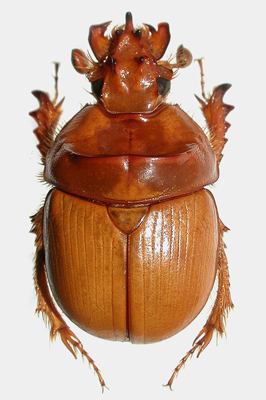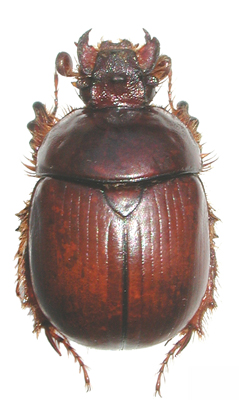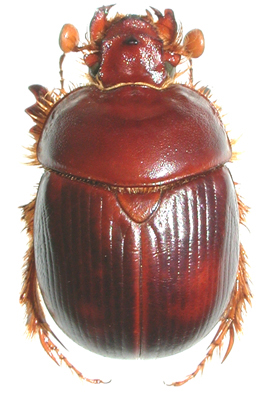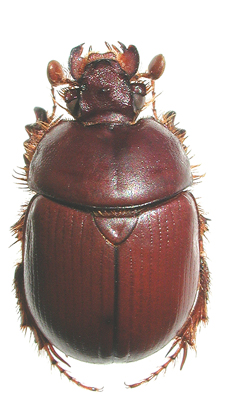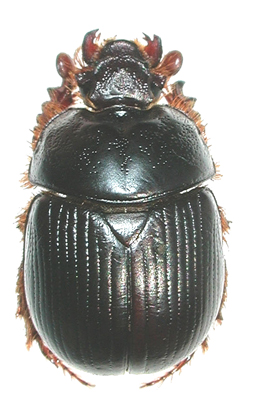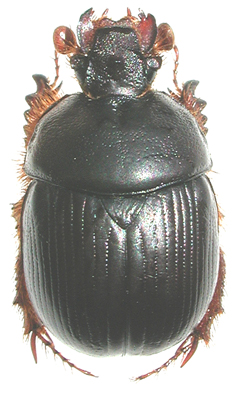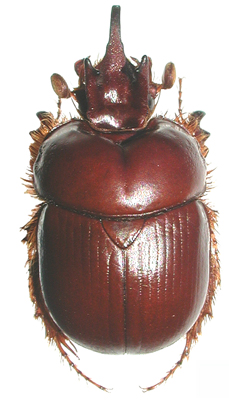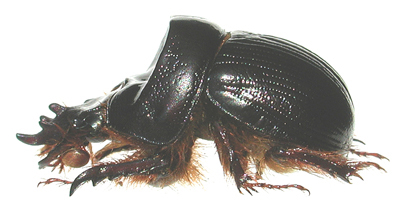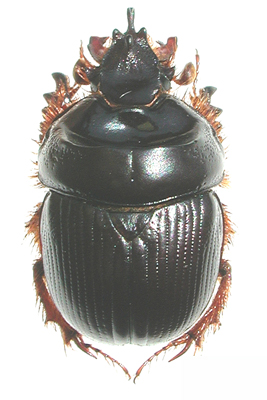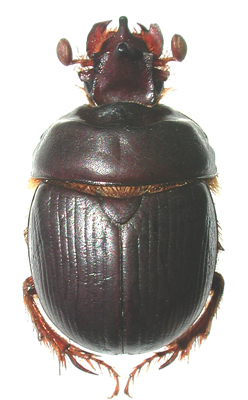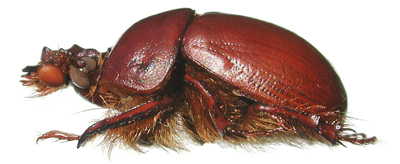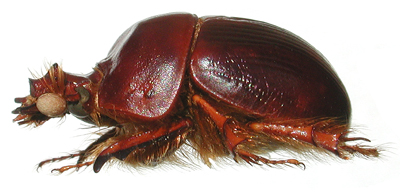
.
KEY TO SPECIES OF BOLBORHINUM
(Bolborhinum seai females are unknown)
(From: Mondaca, J. and A.B.T. Smith. Submitted. A revision of the southern South American genus
Bolborhinum Boucomont (Coleoptera: Geotrupidae: Bolboceratinae). Zootaxa).
.
Note: females, particularly smaller or worn individuals, are very difficult to identify past couplet 9 of this key. Distribution, association with males, and examination of long series will all increase the chances of positively identifying female specimens. |
||||||||||||||||||
| . | ||||||||||||||||||
1. Head dorsomedially with 4 tubercles forming a trapezoid (broadest basally) (Figs. 19-20). Clypeal margin reflexed with two tubercles or teeth. Well-developed individuals with longitudinal carinae between head tubercles and sometimes joining the clypeal tubercles. Males and females …........…................................. Bolborhinum laesicolle (Fairmaire, 1856)
|
||||||||||||||||||
| . | ||||||||||||||||||
2(1'). Head with 5 distinct horns (Figs. 24-25), 1 horn a clypeal apex, 2 clypeal horns on either side of midline towards base of clypeus (not on lateral margin), 2 frontal horns on either side of midline slightly apical from eyes. Known only from northern Argentina (Catamarca) ....................................................... Bolborhinum seai (Martínez, 1951)
|
||||||||||||||||||
| . | ||||||||||||||||||
3(2'). Clypeus with a distinct horn or horns (horns rarely worn down to look like tubercles, wearing is evident); apex of clypeus never with parabolic, blade-like carina. Males ….................................................................................. 4
|
||||||||||||||||||
| . | ||||||||||||||||||
4(3'). Head with a single, large clypeal horn (Figs. 21-22); frontal horn/tubercle absent .............. Bolborhinum nasutum (Fairmaire and Germain, 1861)
|
||||||||||||||||||
| . | ||||||||||||||||||
5(4'). Head with 1 large apically projecting clypeal horn and 2 large horns originating from supraocular margin (Figs. 30, 32). Well-developed individuals with an additional pair of lateral processes on the clypeal horn …..……...................................……….. Bolborhinum tricorne (Solier, 1851)
|
||||||||||||||||||
| . | ||||||||||||||||||
6(5'). Head with 4 distinct horns, 3 clypeal horns and 1 frontal horn forming the corners of a diamond shape (Figs. 13, 36), 2 lateral clypeal horns not on margin ……………………………..…. Bolborhinum tubericeps (Fairmaire, 1856)
|
||||||||||||||||||
| . | ||||||||||||||||||
7(6'). Head laterally with distinct blade-like process or horn on margin (Figs. 26, 28)…………......……………... Bolborhinum shajovskoyi (Martínez, 1952)
|
||||||||||||||||||
| . | ||||||||||||||||||
8(7'). Head with two horns, basal horn located between eyes; apex of the clypeal horn trilobed, frontal horn bifurcate ….……..….......….….……..….......…. .….......….….……..…..Bolborhinum trilobulicorne Mondaca and Smith, 2008 |
||||||||||||||||||
| . | ||||||||||||||||||
9(3'). Pronotum with small, round depression in the apical margin; pronotum impunctate in medial third of disc …….….……..….......….….……..….......….….……..…. .….......….….……..….Bolborhinum.nasutum (Fairmaire and Germain, 1861) |
||||||||||||||||||
| . | ||||||||||||||||||
10(9'). Supraocular margin elevated, cariniform, arcuate in posterior half (lateral view) (Figs. 10, 31, 33) .….… Bolborhinum tricorne (Solier, 1851)
|
||||||||||||||||||
| . | ||||||||||||||||||
11(10'). Pronotum with thin, apical depression; pronotum with large punctures scattered unevenly across disc ...... Bolborhinum tubericeps (Fairmaire, 1856) |
||||||||||||||||||
| . | ||||||||||||||||||
12(11'). Head with clypeal tubercle elevated (Figs. 8, 27, 29), with prominent lateral cariniform processes. More common in Argentina, but also known from IX Región de La Araucanía, Chile ..................... Bolborhinum shajovskoyi (Martínez, 1952)
|
||||||||||||||||||
13(12'). Pronotum anteromedially with furrow; dorsal surface with larger punctures concentrated laterally, at medial furrow, and on pronotal depression ……………………………….Bolborhinum trilobulicorne Mondaca and Smith, 2008 |
||||||||||||||||||
Authors: Jose Mondaca (Servicio Agrícola y Ganadero, Santiago, CHILE) and Andrew Smith (
Canadian Museum of Nature). |


